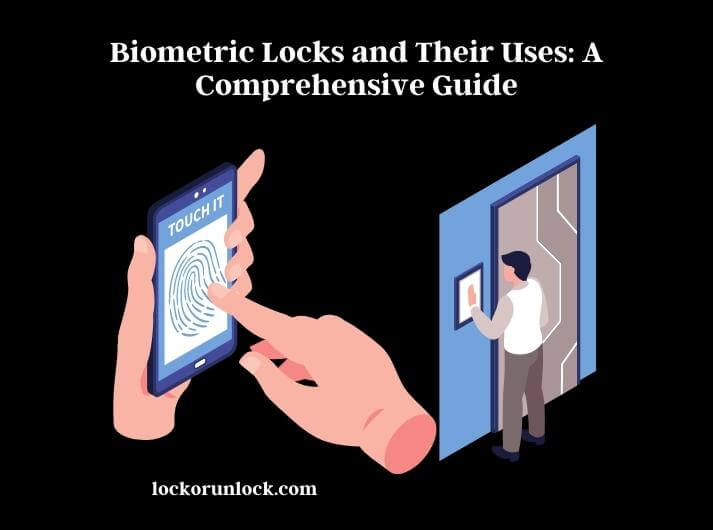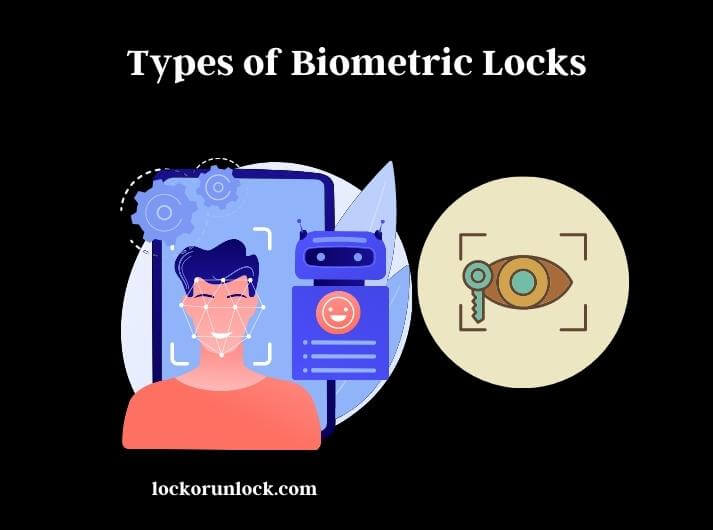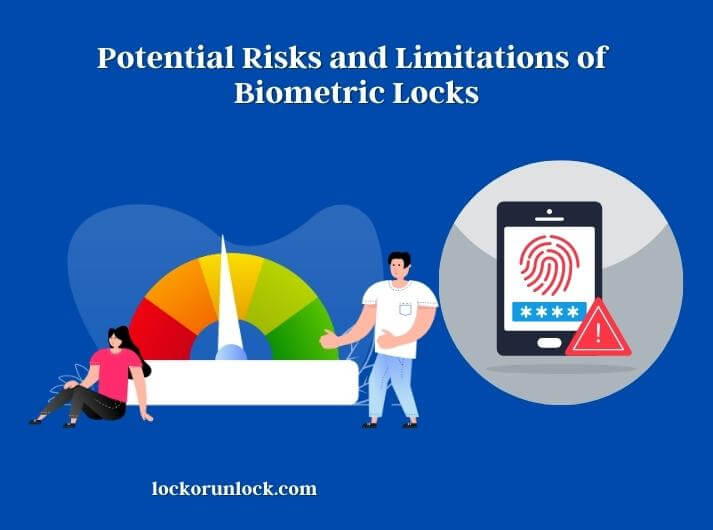The concept of biometric locks has been around for a while, but it wasn’t until recently that they have become more accessible and widely used. With an increasing emphasis on security, biometric locks have emerged as a highly effective solution for access control. These locks use a person’s biological data, such as fingerprints, facial recognition, iris recognition, or voice recognition to grant access to a space.

Biometric locks offer a higher level of security than traditional locks as they use data that is unique to each individual. Additionally, they are highly convenient, eliminating the need to carry keys or remember passwords.
Types of Biometric Locks
There are several types of biometric locks available in the market, each with its own unique features and benefits. Some of the most common types of biometric locks are:
Fingerprint Recognition Locks
These locks are the most widely used type of biometric lock and use a person’s fingerprint (fingerprint locks offer a level of security that traditional locks cannot provide) to grant access. They are easy to use, relatively affordable, and provide a high level of security. Fingerprint recognition locks can be found in many settings, including homes, offices, and schools.
Facial Recognition Locks
These locks use facial features to identify and grant access. They work by analyzing a person’s facial features, such as the distance between the eyes, the shape of the nose, and the contours of the face. Facial recognition locks are becoming increasingly popular in commercial and government settings, such as airports and banks.

Iris Recognition Locks
These locks use a person’s unique iris pattern to grant access, making them one of the most secure types of biometric locks. Iris recognition locks are commonly used in high-security settings, such as government buildings and research facilities.
Voice Recognition Locks
These locks use the sound of a person’s voice to identify and grant access. They analyze the person’s voice pattern, including their pitch, tone, and speech patterns. Voice recognition locks are commonly used in high-security areas, such as military installations.
Each type of biometric lock has its own unique advantages and disadvantages. It is important to consider the level of security required, the environment in which the lock will be used, and the budget available when choosing a biometric lock.
Common Uses of Biometric Locks
Biometric locks are used in a wide range of settings, from personal homes to high-security government facilities. Some of the most common uses of biometric locks are:
| Home Security | Biometric locks are a popular choice for home security as they offer a high level of convenience and security. Homeowners can use fingerprint recognition locks or facial recognition locks to grant access to family members, friends, or trusted contractors, without the need for keys. |
| Business Security | Biometric locks are also used in commercial settings, such as offices, factories, and warehouses, to control access and increase security. Biometric locks are particularly useful for controlling access to restricted areas, such as server rooms or research labs. |
| Financial Institutions | Biometric locks are commonly used in financial institutions, such as banks and credit unions, to protect sensitive information and assets. Iris recognition locks or facial recognition locks are often used to control access to vaults or safety deposit boxes. |
| Government Facilities | Biometric locks are used in various government facilities, including military installations, research labs, and high-security prisons. Voice recognition locks or iris recognition locks are commonly used in these settings to control access to restricted areas and ensure that only authorized personnel can enter. |
| Healthcare | Biometric locks are also used in healthcare facilities, such as hospitals and clinics, to control access to sensitive patient data and medication storage areas. Fingerprint recognition locks are commonly used in medication storage areas to ensure that only authorized personnel can access the medication. |
Biometric locks offer a high level of security and convenience in a wide range of settings. They can be customized to fit the specific needs of each environment, making them a versatile and reliable option for access control.
Factors to Consider When Choosing a Biometric Lock
When choosing a biometric lock, there are several factors to consider to ensure that you choose the right lock for your needs. Some of the most important factors to consider are:
Security
The level of security required is one of the most important factors to consider when choosing a biometric lock. Different types of biometric locks offer different levels of security, and the level of security needed will depend on the specific use case. For example, a high-security government facility may require an iris recognition lock, while a residential home may only need a fingerprint recognition lock.
User-Friendliness
Biometric locks should be easy to use and understand for all users. The lock should be easy to program and operate, and the software should be user-friendly. Additionally, the lock should be able to recognize users quickly and accurately to prevent delays or access issues.
Environment
The environment in which the lock will be used is an important factor to consider when choosing a biometric lock. Outdoor locks will need to be weather-resistant and durable, while locks used in healthcare settings will need to be easy to clean and sanitize.
Cost
The cost of the biometric lock is also an important factor to consider. Different types of biometric locks have different costs, and the cost will depend on the features and level of security needed. It is important to choose a lock that fits within the budget while also providing the required level of security.
Compatibility
Biometric locks should be compatible with existing security systems and access control protocols. It is important to ensure that the lock can integrate with existing systems to ensure seamless operation.
It is important to work with a reputable and experienced biometric lock provider to ensure that you get the right lock for your requirements.
Advantages of Biometric Locks
Biometric locks offer a number of advantages over traditional locks, including:
High Security: Biometric locks offer a high level of security, as they use unique biological characteristics to grant access. This means that only authorized users can access the secured area, and there is no need to worry about lost keys or unauthorized access.
Convenience: Biometric locks offer a high level of convenience, as there is no need to carry keys or remember passwords. Users can simply scan their biometric data, such as a fingerprint or face, to gain access.
Customization: Biometric locks can be customized to fit the specific needs of each environment. This means that the level of security, access protocols, and user permissions can be tailored to the specific requirements of the user.
Audit Trail: Biometric locks offer an audit trail, which records who accessed the secured area and when. This information can be used for security purposes, as well as for tracking employee attendance or monitoring access to sensitive areas.
Durability: Biometric locks are typically more durable than traditional locks, as they are not susceptible to damage from physical force or wear and tear. This means that they offer a longer lifespan and require less maintenance.
Improved Efficiency: Biometric locks can improve efficiency in a number of ways, such as reducing the time and effort required for key management, eliminating the need for security personnel to monitor access, and reducing the risk of human error in granting access.
As biometric technology continues to advance, biometric locks are likely to become even more secure, user-friendly, and versatile, making them an increasingly popular choice for access control in a wide range of settings.
Potential Risks and Limitations of Biometric Locks
While biometric locks offer many advantages, they also come with potential risks and limitations that should be considered. Some of the most significant risks and limitations include:

False Positives and Negatives
Biometric locks may produce false positives, where an unauthorized user is granted access, or false negatives, where an authorized user is denied access. This can occur due to issues with the biometric data, such as poor image quality, or due to environmental factors, such as lighting or temperature.
Privacy Concerns
Biometric data is highly personal and sensitive, and there are concerns about the potential misuse of this data. There is a risk that the biometric data could be stolen or hacked, which could lead to identity theft or other types of fraud.
Compatibility Issues
Biometric locks may not be compatible with all types of security systems or access protocols. This can make it difficult to integrate the biometric lock with existing security systems or to transfer data between different systems.
Cost
Biometric locks can be more expensive than traditional locks, and there may be additional costs associated with training, maintenance, and software updates.
Vulnerability to Spoofing
Biometric locks may be vulnerable to spoofing, where an attacker creates a fake biometric sample to gain unauthorized access. This can occur through a variety of methods, such as using a photograph or creating a fake fingerprint.
Cultural and Legal Considerations
Biometric locks may not be appropriate for all cultures or legal jurisdictions. For example, some cultures may have religious or social concerns about the collection and use of biometric data, while some countries may have laws that restrict the use of biometric technology.
Frequently Asked Questions
1. What Are Biometric Locks?
Biometric locks are advanced security systems that use unique physical or behavioral attributes of individuals, such as fingerprints, iris patterns, or facial recognition, to grant or deny access. They are designed to offer superior security by ensuring that only authorized individuals can unlock the system. The uniqueness of biometric data makes it nearly impossible to replicate or forge, thus providing enhanced security.
2. How Do Biometric Locks Work?
Biometric locks operate by comparing the biometric data being presented to the pre-recorded data stored in the system. When setting up the lock, the user’s biometric data (e.g., a fingerprint or a facial scan) is recorded and stored. Whenever access is attempted, the system compares the current data to the stored one. If there’s a match, the lock grants access, otherwise, it denies.
3. What Are Some Common Uses for Biometric Locks?
Biometric locks can be used in a variety of settings to enhance security. For homes, they can be used on doors to restrict access and eliminate the need for physical keys. In businesses, biometric locks are often used for secure areas, such as data centers or confidential record rooms, ensuring only authorized personnel can access these areas. They are also commonly used in government buildings, laboratories, and other high-security areas.
4. What Are the Benefits of Biometric Locks?
The primary benefit of biometric locks is enhanced security. Given that they use unique biological data, it’s nearly impossible to duplicate access. They also eliminate the issues related to lost, stolen, or copied keys. Moreover, they provide a record of who accessed a particular area and when, which can be useful for auditing and security purposes. Lastly, biometric locks can often be integrated with other security systems for a more comprehensive solution.
5. Are There Any Concerns or Risks Associated With Biometric Locks?
While biometric locks offer significant advantages, there are some potential concerns. These include privacy issues, as some people may not be comfortable with their biometric data being stored. Additionally, there’s a risk of system failure, either due to technical problems or due to the failure to recognize the stored biometric data (e.g., if a person’s finger is dirty, the fingerprint scanner may not recognize it). However, most high-quality biometric systems have fail-safes and multi-factor authentication options to address these concerns.
Last Remarks
Biometric locks offer a range of advantages over traditional locks, including increased security, convenience, customization, durability, and efficiency. They use unique biological characteristics to grant access, which means that only authorized users can access the secured area, and there is no need to worry about lost keys or unauthorized access. Biometric locks can be customized to fit the specific needs of each environment, and offer an audit trail that records who accessed the secured area and when.
There are also potential risks and limitations associated with biometric locks, such as false positives and negatives, privacy concerns, compatibility issues, cost, vulnerability to spoofing, and cultural and legal considerations. It is important to carefully consider these risks and limitations before choosing a biometric lock and to select a lock that offers the right balance of security, convenience, and cost-effectiveness for the specific needs and requirements of the user.
Biometric locks are an increasingly popular choice for access control in a wide range of settings, including homes, businesses, government buildings, and more. As biometric technology continues to advance, biometric locks are likely to become even more secure, user-friendly, and versatile, offering even more advantages for users who want to enhance the security and convenience of their access control systems.
You might also like:
